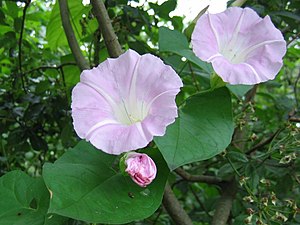Nice bindweed
| Nice bindweed | ||||||||||||
|---|---|---|---|---|---|---|---|---|---|---|---|---|

Beautiful bindweed ( Calystegia × pulchra ) |
||||||||||||
| Systematics | ||||||||||||
|
||||||||||||
| Scientific name | ||||||||||||
| Calystegia pulchra | ||||||||||||
| Brummitt & Heywood |
The beautiful bindweed ( Calystegia × pulchra Brummitt & Heywood ) belongs to the bindweed family (Convolvulaceae). It is the hybrid Calystegia pellita × Calystegia silvatica .
Identifying features
It is a perennial herbaceous plant . It climbs about 1 to 3 meters high with the twisting shoot. The petioles and flower stalks are partly hairy, and the stem can also be hairy. The beautiful bindweed is particularly noticeable for its pink colored crown, which has 5 white stripes, is about 4 to 6 cm long and just as wide. It can be distinguished from the very similar real bindweed by the vesicular distended calyx before leaves.
The number of chromosomes is 2n = 22.
distribution
The origin of the beautiful bindweed is unclear, Haeupler and Muer state Northeast Asia as their home, Oberdorfer writes “maybe East Asia”. The species is not recorded in the “Flora of China”. In the "Rothmaler", on the other hand, Western and Central Europe is named as home, in R. Govaerts "Europe". It is rarely found as an ornamental plant.
In Europe they can be found in alluvial forests and brooks, as well as in fresh ruderal locations and herbaceous fields. It prefers nutrient-rich locations. She naturalized herself as a neophyte in societies of the Galio-Urticenea subclass. In the Allgäu Alps, it rises in Oberjoch in Bavaria to an altitude of 1150 meters.
ecology
The beautiful bindweed is one of the creeping pioneer plants because of its deep creeping, underground shoot axes . The tips of the shoots perform circular search movements ( nutations ) in an anti-clockwise direction in order to be able to wind up on a suitable base. The pollination is mainly by butterflies.
literature
Most of the information in this article comes from:
- Henning Haeupler , Thomas Muer: picture atlas of the fern and flowering plants of Germany (= the fern and flowering plants of Germany. Volume 2). Published by the Federal Agency for Nature Conservation. Ulmer, Stuttgart 2000, ISBN 3-8001-3364-4 , p. 390.
- Erich Oberdorfer : Plant-sociological excursion flora . 7th edition. Ulmer, Stuttgart 1994, ISBN 3-8252-1828-7 , pp. 772 .
- Eckehart J. Jäger, Friedrich Ebel, Peter Hanelt, Gerd K. Müller (eds.): Rothmaler excursion flora from Germany . 5: Herbaceous ornamental and useful plants. Spectrum Academic Publishing House, Berlin Heidelberg 2008, ISBN 978-3-8274-0918-8 , p. 431 .
Individual evidence
- ↑ a b Rafaël Govaerts (Ed.): Calystegia pulchra. In: World Checklist of Selected Plant Families (WCSP) - The Board of Trustees of the Royal Botanic Gardens, Kew . Retrieved November 20, 2017.
- ↑ a b Erich Oberdorfer : Plant-sociological excursion flora for Germany and neighboring areas . With the collaboration of Angelika Schwabe and Theo Müller. 8th, heavily revised and expanded edition. Eugen Ulmer, Stuttgart (Hohenheim) 2001, ISBN 3-8001-3131-5 , pp. 772 .
- ↑ Fang Rhui-cheng, Richard K. Brummitt: Calystegia . In: Flora of China . Vol. 16, p. 286. online
- ↑ Erhard Dörr, Wolfgang Lippert : Flora of the Allgäu and its surroundings. Volume 2, IHW, Eching 2004, ISBN 3-930167-61-1 , p. 359.
Web links
- Nice bindweed. In: FloraWeb.de.
- Nice bindweed . In: BiolFlor, the database of biological-ecological characteristics of the flora of Germany.
- Calystegia pulchra Brummitt & Heywood In: Info Flora , the national data and information center for Swiss flora . Retrieved February 2, 2016.
- Thomas Meyer: Bindweed data sheet with identification key and photos at Flora-de: Flora von Deutschland (old name of the website: Flowers in Swabia )
